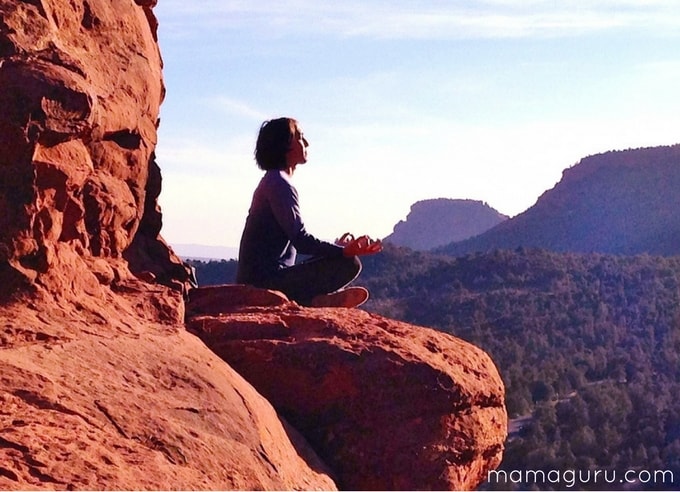
It seems blissful enough. Sitting in lotus position, perhaps in front of a candle, a vase of flowers, or a small makeshift alter. You gently close your eyes, feel your breath and drift into relaxing contemplation. Lovely, just lovely.
In reality many of us feel a wide gap between our actual experience of meditation and the idyllic image of meditation we strive to achieve. Our bodies ache, itch or are suddenly stricken with a need to wiggle as if we are a squirmy toddler. Our minds wander, but never to harmonious ocean scenes or floating lotus blossoms. No, we are busy remembering that we forgot to pick up bananas at the grocery store, worrying that the baby is going to wake up any minute, so we better hurry up and relax, or struggling with our frustration at not being able to keep our mind blank. We are not reaching any state of relaxation, let alone enlightenment. So, we give up.
Please, dear reader, don’t give up. Meditation is a powerful spiritual tool, but sometimes in our quest to learn, we try too hard. It’s like a child’s recipe for Magic Mud, the substance that remains solid if you let is rest on your open palm, but turns to liquid and slips through your fingers the very moment you try to grasp it. The art of meditation is learning to hold without holding.
Here are a few simple suggestions to begin your meditation practice:
First, observe the word practice. We practice meditation, we don’t perfect it. Think of a child learning a musical instrument and the cacophony their practice brings. That should be your expectation. You are going to be clumsy, noisy, and all over the place in the beginning. That is OK. That is more than OK; it is how it should be. It’s the beginning. It is just as unfair to expect yourself to exude the peace of a wise old yogi when you begin meditation as it would be to expect a fourth-grader’s first attempt at the cello to sound like Yo Yo Ma. Be gentle.
Second, give yourself permission to move. If your feet go numb or your mosquito bite itches, shift your body, scratch the itch. Rather than viewing this as a failure, view it as an act of flexibility. When you are more experienced, you’ll naturally be able to sit in stillness longer and you will receive great benefit by learning to control your senses, but that is later. For now, by allowing yourself to wiggle a bit, you may free yourself from your desire to wiggle. The urge to move when you are supposed to be still is merely an act of resistance you will work through in time. Remove the stillness rule to lessen your own resistance. Be gentle.
To begin, let your meditation be all about your breath. Sit down in a comfortable position. Let your hands rest with palms open to the sky. This gesture will remind you not to hold onto your practice. Let it be whatever it will be this day. Take notice of your spine which holds your essential life force. Keep it tall by bringing in just enough muscles to support it. Close your eyes and sit for a few moments taking inventory of your body and mind. How are you feeling today? Try not to analyze, rather observe. Take note of your physical sensations, thoughts, anxieties, and energy level.
After you’ve settled into your position, draw your attention to your breath. Simply observe it. Is it fast and shallow, or slow and deep? Are your inhalations and exhalations balanced, or is one longer than the other? After observing for a few moments, bring consciousness to your breath by silently whispering the sound, so, as you inhale and, ham (pronounce the vowel like ahhh) as you exhale. This classic yogic phrase means, “I am That.” Try to bring your breath to even inhalations and exhalations. Completely fill and completely empty your lungs with each breath. Be gentle.
This is the simplest practice of meditation, but it is very powerful. Breath is the essence of life. Concentrating on your breath is the easiest way to bring your attention to the present moment. During your practice, your sounds, so and ham, may or may not dissolve. Allow that to happen. If you notice your mind wandering to any particular thoughts, return to so ham.
Your practice will be whatever length it’s supposed to be, so you don’t need a time limit or expectation. Before you close your practice, do a quick scan of your body and mind. Observe any changes from the beginning of your practice and simply take note. Bring your palms together at your heart center in gratitude, then let it go. That was one practice. It may have been amazing. It may have been disappointing. There will be another practice tomorrow. This is meditation. Hold without holding.
Namaste.






[…] Integrate stress reduction activities into your daily life. This could mean yoga, meditation, a walk outside, play with animals, breathing exercises, tai chi, or a quiet hobby you enjoy. […]